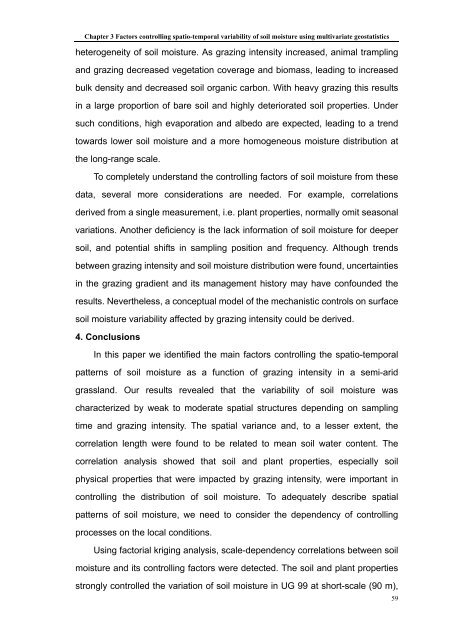SCHRIFTENREIHE Institut für Pflanzenernährung und Bodenkunde ...
SCHRIFTENREIHE Institut für Pflanzenernährung und Bodenkunde ...
SCHRIFTENREIHE Institut für Pflanzenernährung und Bodenkunde ...
Create successful ePaper yourself
Turn your PDF publications into a flip-book with our unique Google optimized e-Paper software.
Chapter 3 Factors controlling spatio-temporal variability of soil moisture using multivariate geostatistics<br />
heterogeneity of soil moisture. As grazing intensity increased, animal trampling<br />
and grazing decreased vegetation coverage and biomass, leading to increased<br />
bulk density and decreased soil organic carbon. With heavy grazing this results<br />
in a large proportion of bare soil and highly deteriorated soil properties. Under<br />
such conditions, high evaporation and albedo are expected, leading to a trend<br />
towards lower soil moisture and a more homogeneous moisture distribution at<br />
the long-range scale.<br />
To completely <strong>und</strong>erstand the controlling factors of soil moisture from these<br />
data, several more considerations are needed. For example, correlations<br />
derived from a single measurement, i.e. plant properties, normally omit seasonal<br />
variations. Another deficiency is the lack information of soil moisture for deeper<br />
soil, and potential shifts in sampling position and frequency. Although trends<br />
between grazing intensity and soil moisture distribution were fo<strong>und</strong>, uncertainties<br />
in the grazing gradient and its management history may have confo<strong>und</strong>ed the<br />
results. Nevertheless, a conceptual model of the mechanistic controls on surface<br />
soil moisture variability affected by grazing intensity could be derived.<br />
4. Conclusions<br />
In this paper we identified the main factors controlling the spatio-temporal<br />
patterns of soil moisture as a function of grazing intensity in a semi-arid<br />
grassland. Our results revealed that the variability of soil moisture was<br />
characterized by weak to moderate spatial structures depending on sampling<br />
time and grazing intensity. The spatial variance and, to a lesser extent, the<br />
correlation length were fo<strong>und</strong> to be related to mean soil water content. The<br />
correlation analysis showed that soil and plant properties, especially soil<br />
physical properties that were impacted by grazing intensity, were important in<br />
controlling the distribution of soil moisture. To adequately describe spatial<br />
patterns of soil moisture, we need to consider the dependency of controlling<br />
processes on the local conditions.<br />
Using factorial kriging analysis, scale-dependency correlations between soil<br />
moisture and its controlling factors were detected. The soil and plant properties<br />
strongly controlled the variation of soil moisture in UG 99 at short-scale (90 m),<br />
59


